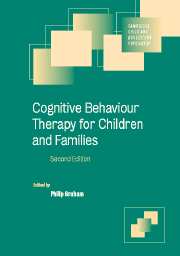Book contents
- Frontmatter
- Contents
- List of contributors
- 1 Introduction
- Part I Developmental cognitive theory and clinical practice
- Part II Engagement and assessment
- Part III Client groups
- Part IV Applications in psychosocial adversity
- Part V Applications in specific child and adolescent psychiatric disorders
- 12 Behavioural approaches to eating and sleeping problems in young children
- 13 Conduct disorders in young children
- 14 Attention deficit hyperactivity disorder
- 15 Children with developmental disabilities and their parents
- 16 Depressive disorders
- 17 Cognitive behavioural psychotherapy for obsessive compulsive disorders
- 18 Anxiety disorders
- 19 School refusal
- 20 Post-traumatic stress disorders
- 21 Disorders of eating control
- 22 Chronic fatigue syndrome
- 23 Children's interpersonal problems
- 24 Pain in childhood
- 25 Conduct disorders in adolescence
- 26 Drug and alcohol abuse
- Part VI CBT applications in preventive interventions
- Index
- References
19 - School refusal
Published online by Cambridge University Press: 21 August 2009
- Frontmatter
- Contents
- List of contributors
- 1 Introduction
- Part I Developmental cognitive theory and clinical practice
- Part II Engagement and assessment
- Part III Client groups
- Part IV Applications in psychosocial adversity
- Part V Applications in specific child and adolescent psychiatric disorders
- 12 Behavioural approaches to eating and sleeping problems in young children
- 13 Conduct disorders in young children
- 14 Attention deficit hyperactivity disorder
- 15 Children with developmental disabilities and their parents
- 16 Depressive disorders
- 17 Cognitive behavioural psychotherapy for obsessive compulsive disorders
- 18 Anxiety disorders
- 19 School refusal
- 20 Post-traumatic stress disorders
- 21 Disorders of eating control
- 22 Chronic fatigue syndrome
- 23 Children's interpersonal problems
- 24 Pain in childhood
- 25 Conduct disorders in adolescence
- 26 Drug and alcohol abuse
- Part VI CBT applications in preventive interventions
- Index
- References
Summary
Introduction
School refusal is a persistent school attendance problem that: jeopardizes a young person's social, emotional, academic and vocational development; contributes to distress for concerned parents and school staff; and often presents a real challenge to education and mental health professionals (Kahn et al., 1996). Some authors (e.g. Kearney and Silverman, 1996) use the term school refusal behaviour to refer to a range of attendance problems, including truancy. Others draw a distinction between school refusal as one type of attendance problem and truancy as another, using the term school refusal to refer to cases where difficulty attending school is associated with emotional distress (e.g. King and Bernstein, 2001), is not associated with serious antisocial behaviour (e.g. Honjo et al., 2001) and involves the child usually staying at home versus being absent from home (e.g. Kameguchi and Murphy-Shigematsu, 2001). Like these authors, the authors of this chapter also prefer to distinguish between school refusal and truancy, as these often require different approaches to intervention (Berg, 2002).
Following the work of Berg and colleagues (Berg et al., 1969; Bools et al., 1990; Berg, 2002), school refusal is defined by: (1) reluctance or refusal to attend school; (2) the child usually remaining at home during school hours, rather than concealing the problem from parents; (3) displays of emotional upset at the prospect of attending school, which may be reflected in excessive fearfulness, temper tantrums, misery or possibly unexplained physical symptoms; (4) an absence of severe antisocial tendencies, beyond the child's resistance to parental attempts to get them to school; and (5) reasonable parental efforts to secure the child's attendance at school, at some stage in the history of the problem.
- Type
- Chapter
- Information
- Cognitive Behaviour Therapy for Children and Families , pp. 320 - 341Publisher: Cambridge University PressPrint publication year: 2004
References
- 6
- Cited by



